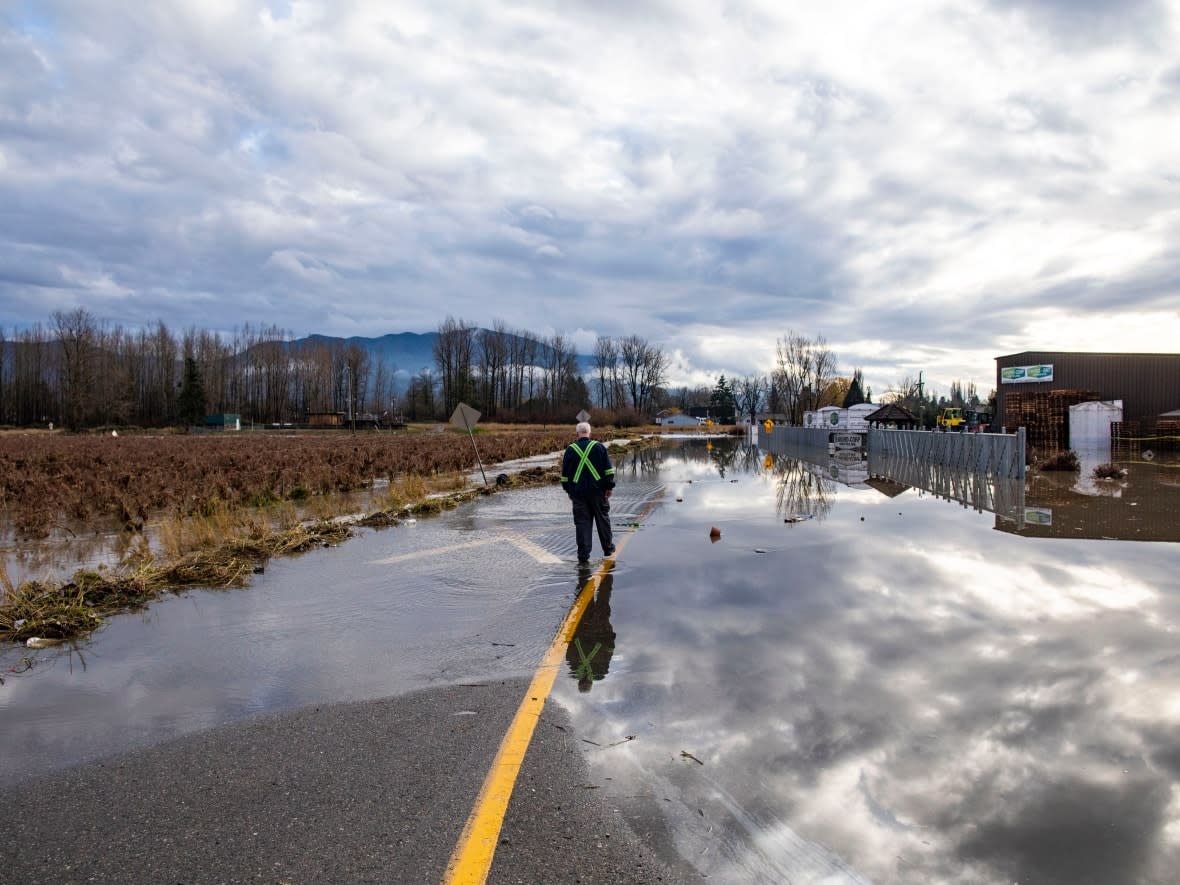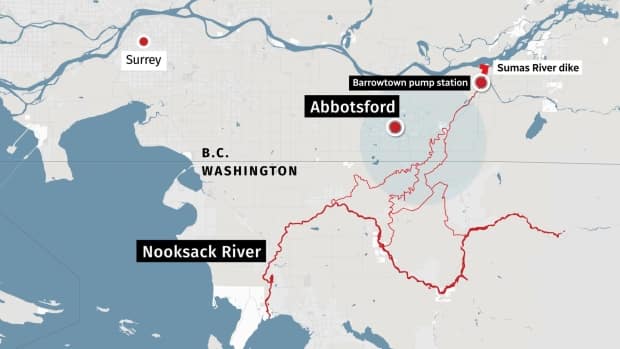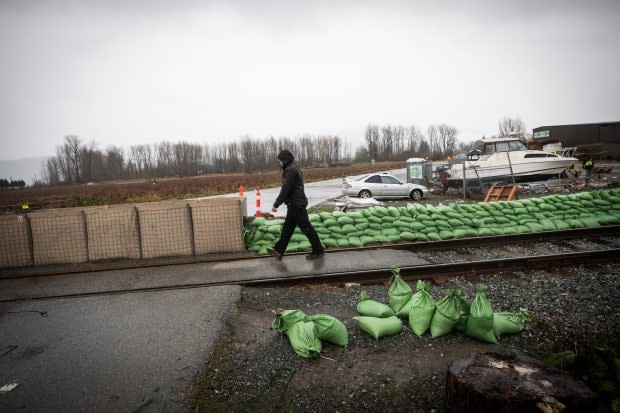Relentless rain prompts more evacuation orders as B.C. braces for 3rd consecutive storm

THE LATEST:
The third in a series of Pacific storms bringing torrential rain to already-flooded areas of southwest B.C. is expected to arrive Tuesday, with up to 100 millimetres of rain predicted for the swamped Fraser Valley.
The third in a series of increasingly intense storms is approaching British Columbia, leaving residents bracing for more torrential rain while officials are still addressing damage done across the Lower Mainland and southern Interior from the last two storms.
Communities across the province were busy preparing for the latest storm during a brief reprieve from the weather in some areas Monday. Farmers rushed again to move dozens of cattle, including calves, to higher ground while residents packed sandbags around their homes.
The next storm is expected to slam into B.C. later Tuesday, with officials warning it could be the worst one in a series of three this month.
Environment Canada has issued a series of special weather alerts for much of B.C.'s southwest and coast, with up to another 100 millimetres of rainfall predicted for the Fraser Valley between Tuesday and Wednesday along with winds up to 60 km/h. Areas of Vancouver Island and the Central Coast could see as much as 200 millimetres of rain.
Geoff Coulson, a warning preparedness meteorologist with Environment Canada, said Monday the storm is expected to hit the North Coast late tonight and move south overnight.
He said the two recent storms dumped precipitation for about 24 to 36 hours, while this one could bring relentless rain for 48 hours.
"The concern with this event is the long duration," said Coulson.
The issue, experts say, is that the ground across much of the region is already soaked to its limit after the previous two storms and can't absorb any more heavy rain.
The first atmospheric river system from Nov. 13 to 15 caused devastating flooding and fatal mudslides. The second forced more evacuations and road closures when it arrived this weekend.
Nooksack River threatens areas of Abbotsford
The Fraser Valley has borne much of the brunt of the flooding. Late Sunday, several more residents of Abbotsford were ordered to leave their homes as the water again threatened to rise.
Crews in the city, including members of the Canadian military, worked through the night to pump water into Tiger Dams to try to hold back floodwaters from the Sumas River. A Tiger Dam is a series of water-filled tubes over a metre in height that are used to create a barrier.
"We are pumping about a billion gallons a day," said Abbotsford Mayor Henry Braun, speaking Monday on The Early Edition.
Braun said his "worst nightmare" would be if the Nooksack River in neighbouring Washington state breaches Abbotsford's dikes.
He said 17 kilometres of the city's dikes have been repaired and reinforced since they were damaged earlier this month, but the mayor is not positive that work will be enough to hold back the Nooksack.
"Once it breached, you had a three-storey wall of water," he said, referring to last time the U.S. river overflowed its banks and crossed the border.
As of Monday morning, Braun said water about 20 centimetres deep was already coming across the border and entering the Sumas Prairie area of Abbotsford, which was extensively flooded after the first storm in mid-November.

Abbotsford city staff are in hourly contact with counterparts in Whatcom County across the border who are monitoring the Nooksack, said Braun.
CBC meteorologist Johanna Wagstaffe said Abbotsford was hit with record rain on the weekend, with 118 millimetres falling on the already saturated city.
The University of the Fraser Valley has cancelled all in-person classes for next week.
Gas limits extended until mid-December
On Monday, the province extended fuel rationing until Dec. 14, when the Trans Mountain pipeline is to be up and running again.
The pipeline has been closed since Nov. 14, when it was damaged in the first rainstorm. The order limits drivers to 30 litres of gas or diesel per trip to the gas station.
B.C. Energy Minister Bruce Ralston says the pipeline provides most of the fuel for B.C.'s Lower Mainland and Vancouver Island, which is now being shipped in by rail from Alberta and on barges from the United States.
The province has also extended its state of emergency until the same date in December to ensure emergency services have the resources they need to respond to the flooding.
State of emergency in Hope
The District of Hope, about 155 kilometres east of Vancouver, declared a state of local emergency on Sunday and later placed homes on Riverview Drive on an evacuation alert.
Hope Mayor Peter Robb told CBC Monday district staff have been piling sandbags along the banks of the Coquihalla River and two evacuation centres are ready to receive people if necessary.
"We're doing the best we can," said Robb, adding residents can stay up to date on the situation on the district's website.
Wagstaffe said Hope had 140 millimetres of precipitation over the weekend.

Evacuation alerts mean residents must be ready to leave their homes at a moment's notice. Evacuation orders mean residents should leave immediately.
On Sunday, B.C.'s River Forecast Centre issued a flood warning for the Coquihalla River and the Sumas River, which affects Sumas Prairie and the surrounding area.
It also upgraded flood watches to warnings for the Tulameen River, Coldwater River and Lower Nicola River.
A flood warning means river levels have exceeded banks and that flooding in nearby areas will occur.

Hwy 1 closed, non-essential travel not advised
Highway 1 remains closed between Abbotsford and Chilliwack because of the rain over the weekend. Officials did not say when the road would reopen.
B.C. Public Safety Minister Mike Farnworth said non-essential travel should be avoided in the coming days as the province braces for the third storm.
Farnworth said the government wants to avoid any unnecessary road closures that would further strain essential resources.
Those who must be on the road should drive carefully and never drive through floodwaters because it's not always clear how deep the water might be, he said.
He also said people should prepare for emergencies by carrying food, water, warm clothes, blankets and well stocked emergency kits in their vehicles.
Farnworth also said the province is prepared to use Alert Ready — a system that pushes emergency notifications directly to cellphones — if local authorities believe the next storm poses a threat to life or public safety.
WATCH | If you're driving, here's how to prepare for an emergency:


